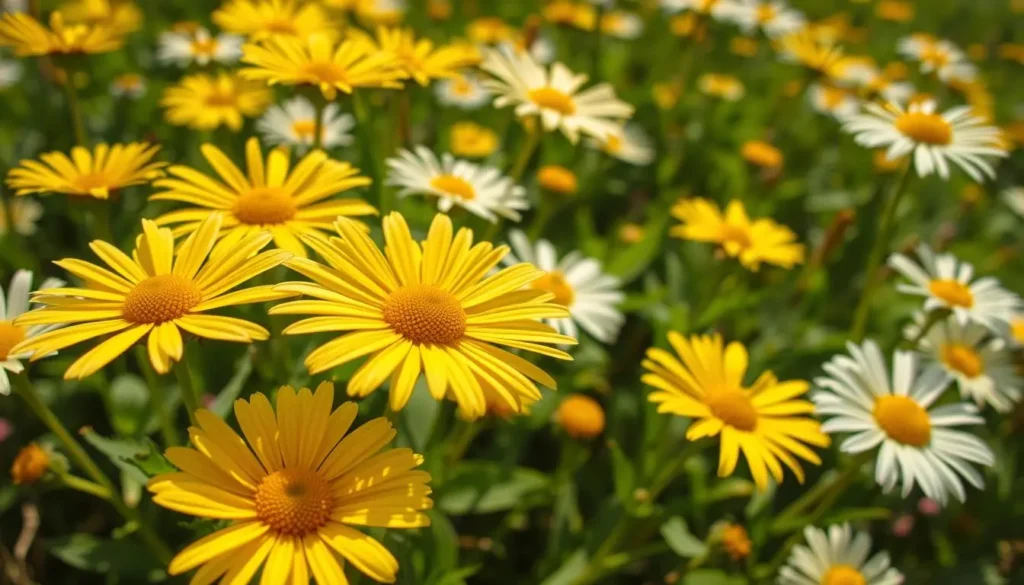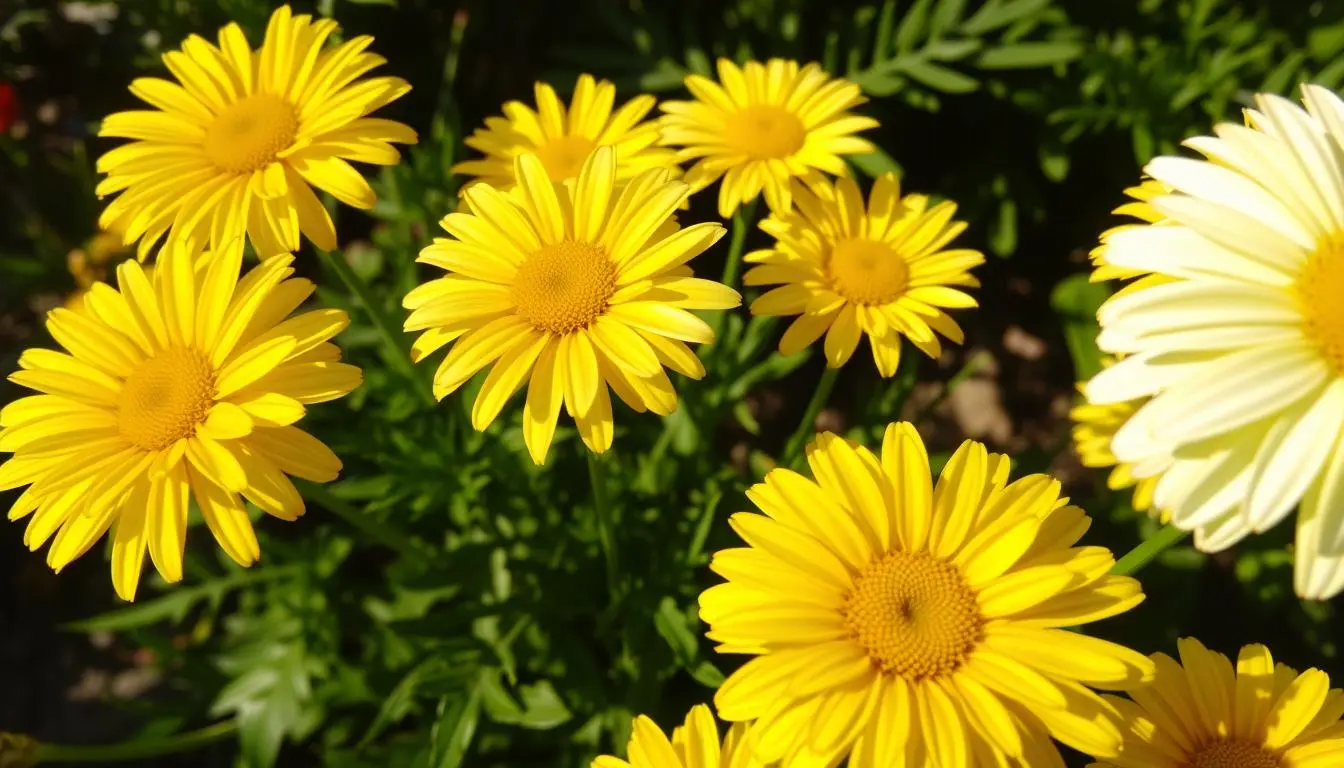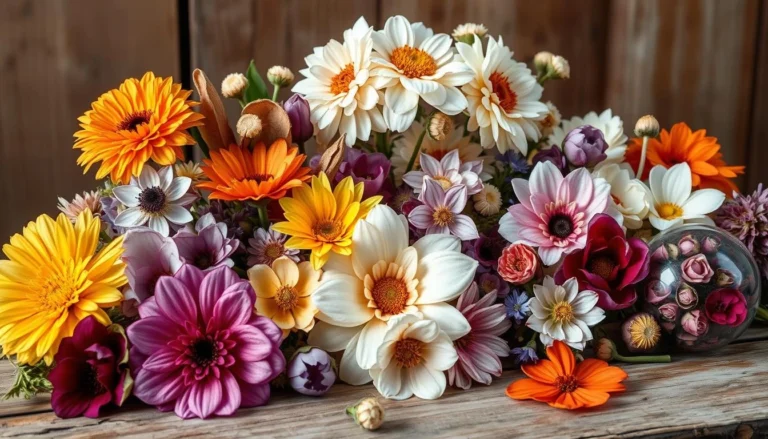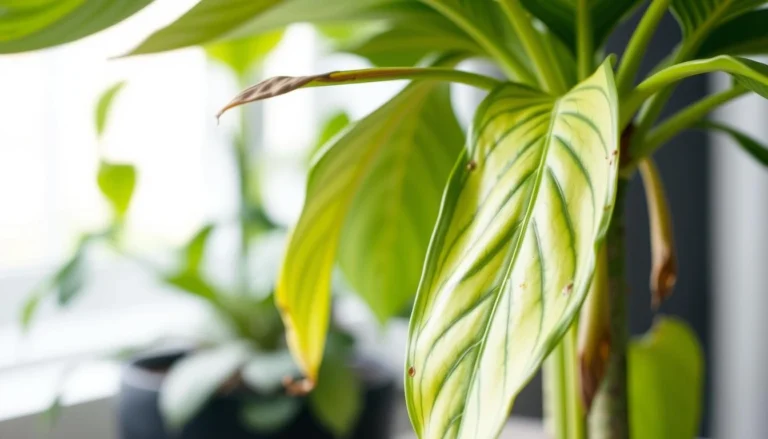Yellow and White Daisy: Expert Tips for Vibrant Blooms
Have you ever looked at a yellow and white daisy and felt amazed by its beauty? Its petals shine like a soft sun. These flowers are not just pretty; they show nature’s strength. But, do you know how to grow these bright flowers in your garden? Learn the expert tips to bring out the best in your yellow and white daisies.
Key Takeaways
- White Cape Daisies bloom from late spring to early summer and last 2-3 weeks1
- They need at least 6 hours of sunlight a day and love well-drained, fertile soil1
- Fertilizing them during the growing season is key for bright blooms1
- Daisies in the Leucanthemum genus, like Shasta Daisies, come in many hardy, long-blooming types2
- Attracting bees and butterflies can help daisies produce more flowers
Flower Characteristics
The white and yellow daisies are a true delight to behold. They have bright white petals and a yellow center, making them visually stunning3. The Amazing Daisies® ‘Banana Cream’ Shasta Daisy is 4 to 5 inches wide3. It grows 15 to 18 inches tall and spreads 18 to 24 inches wide3.
Description of Colors and Structure
White and yellow daisies come in many shades, from pure white to soft yellows4. There are over 20,000 types of daisies, showing their amazing diversity4. These flowers have a unique structure, with white or yellow petals around a yellow center. The different shapes and sizes of petals make each bloom unique and attractive.
Self-Pollination vs. External Pollination
White and yellow daisies can pollinate themselves3. They grow best in USDA zones 5 through 93. They need at least 6 hours of sunlight a day to thrive3.
While they can pollinate themselves, attracting bees and butterflies can make more flowers3. This mix of self-pollination and external pollination makes the flowers bloom more vibrantly.
| Daisy Variety | Native Origin | USDA Hardiness Zones | Typical Height |
|---|---|---|---|
| Common English Daisy (Bellis perennis) | Europe | 4–8 | 3–6 inches |
| Gerbera Daisy (Gerbera jamesonii) | South Africa | 8–10b (annual elsewhere) | 12–18 inches |
| Marguerite Daisy (Argyranthemum frutescens) | Canary Islands | 10–11 (annual elsewhere) | 2–3 feet |
| Oxeye Daisy (Leucanthemum vulgare) | Europe | 3–8 | 1–3 feet |
| Painted Daisy (Tanacetum coccineum) | Eastern Europe, Iran, Central Asia | 3–7 | 2–3 feet |
| Shasta Daisy (Leucanthemum x superbum) | Europe, Japan | 4–9 | 1–4 feet |
| Swan River Daisy (Brachyscome iberidifolia) | Australia | 2–8 (annual), 9-11 (perennial) | 1 to 1.5 feet |
| Gloriosa Daisy (Rudbeckia hirta) | North America | 3-8 | 2 to 3 feet |
| Golden Marguerite (Anthemis tinctoria) | Europe, Mediterranean, Western Asia | 3-8 | 2 to 3 feet |
| Coneflower (Echinacea) | North America | 3-8 | 2 to 4 feet |
| Cape Daisy (Osteospermum) | South Africa | 10-11 | 1 to 3 feet |
| Chrysanthemum | Various | Various | Various |
5 The table above shows the wide range of daisy varieties, their origins, growing zones, and heights5. This information helps gardeners and enthusiasts choose and grow white and yellow daisies5.
Blooming Process
The white and yellow daisy’s blooming journey is a three-act play that lasts several weeks6. It starts with the formation of flower buds, marking the beginning of this colorful show6. As these buds grow, they move into the second stage: full bloom. Here, the petals open wide, and the flowers shine at their best6.
Typical Bloom Time and Duration
The white and yellow daisy blooms from late spring to early summer. This period is about 2-4 weeks from bud to full bloom6. After reaching full bloom, these flowers stay bright for about 2-3 weeks. Then, they start to fade6.
Lifespan of Flowers
Many things can affect how long these daisies last. Weather, how much water they get, and the soil’s health are key6. With the right care, these daisies can bloom year after year. They bring vibrant colors to your garden6.
| Blooming Stage | Timeline | Lifespan |
|---|---|---|
| Bud Formation | 2-4 weeks | N/A |
| Full Bloom | 2-4 weeks | 2-3 weeks |
“The white and yellow daisy, with its vibrant petals and captivating display, is a true delight to behold in any garden.”
Encouraging Blooms
To get your white and yellow daisies to bloom well, start with the right growing conditions. These flowers love full sun, so they need at least six hours of direct sunlight each day7. Also, water them consistently but avoid making the soil too wet, as this can damage the roots7.
Fertilizing is also important for bright blooms. Use a balanced fertilizer during the growing season to give your daisies the nutrients they need7. Keeping the soil well-drained and fertile, with organic matter, will help them stay healthy and bloom well78.
Tips for Encouraging Blooming
- Ensure your white and yellow daisies receive at least 6 hours of direct sunlight per day7
- Keep the soil consistently moist, but avoid waterlogging7
- Use a balanced fertilizer during the growing season to provide essential nutrients7
- Amend the soil with organic matter to improve drainage and fertility78
Factors Influencing Flowering
Temperature is key for your yellow-and-white daisies. They grow best in temperatures between 20°C to 30°C (68°F to 86°F)7. Remember, pruning is important too. Regular deadheading will encourage new blooms, keeping your garden colorful all season78.
By following these tips, you can create the perfect growing conditions for an abundance of vibrant white and yellow daisy blooms in your garden.
Post-Flowering Care
When your white and yellow daisy or yellow-and-white daisy flowers start to fade, don’t worry. These plants are not done yet. They move on to making seeds9.
Seed production is key for your white and yellow daisies to grow strong in the future. Even though the flowers may not be as bright, your yellow and white daisies are still working hard. With the right care, they can bloom again and again all season10.
To keep your white and yellow daisy plants looking their best, follow these care tips:
- Watering: Keep the soil moist but not too wet9.
- Fertilization: Use a balanced fertilizer to help them grow10.
- Pruning: Remove dead flowers to encourage new ones9.
By taking these simple steps, your white and yellow daisies will stay healthy and beautiful. They’ll keep dazzling you with their blooms10.

“With the right care, your yellow and white daisies can continue to thrive long after their initial bloom.”
Unique Aspects
The yellow and white daisies are more than just pretty flowers. They have special traits that make them stand out in any garden11. They come in different sizes, from small to tall, and some even fight off diseases better and bloom longer11.
Unusual Characteristics
These daisies are rare and have unique looks11. Some, like ‘Snowcap’ and ‘Tetra,’ have special colors and shapes. They are rare, making them extra special for gardeners11.
Trivia About Reproductive Strategies
The way yellow and white daisies make more plants is interesting12. Shasta Daisies bloom from summer to early fall. Feverfew blooms even longer, from spring to fall12. This means they attract pollinators all season, helping the environment.
These daisies also have deep meanings13. Common Daisies mean innocence and purity. Gerbera daisies show happiness and hope13. Shasta daisies are especially loved for their simple beauty13.
Yellow and white daisies are special for many reasons11. They are good at surviving without water, attract pollinators, and have deep meanings. By understanding these qualities, gardeners can make beautiful and helpful spaces with these amazing flowers.
yellow and white daisy
The yellow and white daisy is a bright and cheerful sight. It has a central disc and delicate rays in shades of yellow and white14. Each flower is different, making the plant even more charming.
The classic yellow and white daisy, like the Oxeye Daisy, is a favorite in art and literature15. The daisy family also includes many other colors, like the Euryops and African Daisies in bright yellows, and the Aster and Purple Coneflower in purples15. This means there’s a daisy for everyone to love.

Yellow and white daisies can be found growing wild or in gardens15. They are loved by many for their beauty and hardiness. They add joy to any space.
The daisy symbolizes purity, loyalty, and happiness16. It grows well in many places, making it a favorite among gardeners and flower lovers.
Varieties and Species
Start your journey into the world of yellow and white daisies. Each variety has its own charm and character. You’ll find everything from the Victorian Secret Shasta Daisy to the Marshmallow Shasta Daisy and the Alaska Shasta Daisy. These flowers are sure to capture your heart and inspire you.
Victorian Secret Shasta Daisy
The Victorian Secret Shasta Daisy (Leucanthemum x superbum ‘Victorina Secret’) is a real showstopper. Its antique white petals and shaggy look make it a favorite of butterflies17. Shasta daisies thrive in USDA Zones 5 through 917. This makes the Victorian Secret a great choice for your garden.
Marshmallow Shasta Daisy
The Marshmallow Shasta Daisy (Leucanthemum x superbum ‘Marshmallow’) is soft, fluffy, and charming. It has a dense growth habit and pure white petals. This variety adds a whimsical touch to any outdoor space18. Shasta daisies grow in zones 4 to 9 and can reach 2 to 3 feet tall18.
Alaska Shasta Daisy
The Alaska Shasta Daisy (Leucanthemum x superbum ‘Alaska’) is bold and striking. Its large white blooms with sunny yellow centers grab attention. It’s perfect for cut flower arrangements or as a statement plant18. Shasta daisies thrive in USDA Zones 4 to 917.
Explore the world of yellow and white daisies and find the perfect one for you. Whether you love the vintage charm of the Victorian Secret, the fluffy Marshmallow, or the bold Alaska, these flowers will bring joy and beauty to your garden.
Planting and Care Guide
Planting Instructions
When planting your white and yellow daisies, pick a spot that gets full sun. They need at least 6 hours of sunlight a day19. Make sure the soil drains well. If it’s too heavy or sandy, add compost to make it better for your plants19.
Plant the yellow-and-white daisies 18 to 24 inches apart. This lets them grow big and breathe well20. When planting, make sure the soil level is even with the root ball. Too much soil can cause rot.
Care Guide
White and yellow daisies are easy to care for once they’re set. Keep the soil moist, especially when they’re new. Water them often when it’s dry to keep them blooming20.
Use organic mulch to keep the soil moist and stop weeds20. If your daisies get too tall, they might need staking to stay upright, especially in windy areas20.
Remove dead flowers to make room for new ones. Cut back dead growth in late fall or early spring to help them grow again20. Every few years, divide big clumps of white and yellow daisies in autumn or spring to keep your garden looking fresh20.
Fertilize with slow-release fertilizer in spring or add compost every year to keep nutrients up19.
If you have yellow and white daisies in pots, water them often and use a monthly fertilizer. When the roots outgrow the pot, it’s time to repot19.

By following these tips, you can enjoy the beautiful flowers of white and yellow daisies in your garden for many years.
Design Ideas and Companions
The white and yellow daisy is a versatile plant that can elevate the beauty of any garden. Its moderate size and upright habit make it an excellent choice for border plantings. It adds a bright, cheerful touch to garden beds and walkways21. Shasta daisies, which can grow 2-4 feet tall and 2+ feet wide, are particularly well-suited for this purpose21.
In addition to their use in borders, white and yellow daisies are also perfect for pots and containers. This allows you to bring the captivating beauty of these flowers to your patio, balcony, or other outdoor living spaces. The large, showy blooms are also ideal for cutting and creating stunning indoor flower arrangements, bringing the garden’s charm into your home.
To enhance the visual appeal and overall health of your yellow-and-white daisy garden, consider incorporating companion plants. Some excellent choices include:
- Marigolds: Known for their pest-repellent properties, particularly against nematodes and aphids, marigolds can help protect your daisies while attracting pollinators22.
- Lavender: This natural pest deterrent effectively keeps moths and fleas at bay, while its contrasting color and texture can elevate the visual appeal of the garden22.
- Chives: Repelling aphids and other harmful insects, chives can also be enjoyed for their edible qualities22.
- Nasturtiums: Serving as a trap crop for aphids, nasturtiums draw pests away from your yellow and white daisies while providing ground cover to prevent weeds22.
- Bee Balm: Attracting bees and butterflies, Bee Balm enhances pollinator activity and creates a visually dynamic landscape22.
- Coreopsis: Attracting beneficial insects and sharing similar care needs with daisies, Coreopsis thrives in full sun and well-drained soil22.
- Echinacea: Attracting pollinators and beneficial insects, Echinacea provides height and texture contrast to enhance garden design22.
By carefully selecting companion plants, you can create a harmonious and balanced garden that promotes the health and beauty of your white and yellow daisies22.
Remember, when choosing companion plants, it’s essential to avoid heavy feeders like sunflowers or corn. They can compete with your daisies for nutrients and potentially weaken them or attract pests22.
| Plant | Height | Width |
|---|---|---|
| Shasta Daisy | 2-4 feet | 2+ feet |
| Campanula | 1 to 6+ feet | N/A |
| Liatris | Up to 4 feet | 1.5 feet |
| Petunia | 8 inches to 2+ feet | 1 foot to 4 feet |
| Lupine | 1.5 to 4 feet | 2-2.5 feet |
| Gladiolus | 3 to 6 feet | N/A |
| Hydrangea | 4 to 8 feet | 4 to 8 feet |
| Crocosmia | 3 to 4 feet | 1+ inch wide sword leaves |
| Sage | 1 to 3 feet | 1 to 2.5 feet |
By incorporating a variety of well-suited companion plants, you can create a visually stunning and ecologically balanced garden. This showcases the beauty of your white and yellow daisies2221.
Conclusion
Choosing the bright yellow-and-white daisy or the classic white one will add joy to your garden. These flowers symbolize innocence, purity, and happiness. They make your garden feel more beautiful and optimistic.
These daisies grow big, bloom for a long time, and are easy to care for. They fit well in many garden types. This makes them a great choice for anyone looking to add beauty to their yard.
Adding white and yellow daisies, yellow-and-white daisy, or yellow and white daisies to your garden will make it colorful and peaceful. They create a space that feels happy and calm. Let these flowers make your garden a place of beauty and joy.
Whether you’re new to gardening or have been doing it for years, the white and yellow daisy is a wonderful pick. It brings magic to your garden. Let these flowers fill your outdoor space with wonder and endless possibilities.







